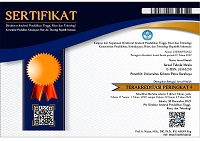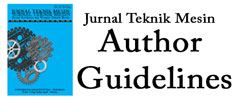Experimental Modal Analysis (EMA) untuk Mengetahui Modal Parameter pada Analisis Dinamik Balok Kayu yang Dijepit di Satu Ujung
Keywords:
Experimental modal analysis, modal parameter, dynamic characteristics, mode shapes.Abstract
Experimental modal analysis (EMA) is one among other methods to analyze dynamics characteristics of the structure. EMA is used widely in structural, automotive engineering, design and machining proccess for determination of modal parameters. EMA measures excitation force and frequency response function of the structure in time domain and then converts these data into frequency domain using Fast Fourier Transfrom (FFT). In this research EMA is applied to analyze the dynamics characteristics of wood structures that would be used as stiffener for boxed shaped work-piece or as a frame for traditional wood ship. The availability of the characteristics dynamics' data for wood are limited, so EMA is very useful tool to determine modal parameters for specific wood structures.Experiments was conducted using modal hammer to excite the wood structure and an accelerometer to measurse the response of the structure as acceleration data. The data acquired by EMA are used to determine modal parameters of wood structure in the terms of natural frequency, mode shapes and damping ratio. The dimension of wood being analyze (length x width x height) is 860 mm x 50 mm x 50 mm. Simulation of modal analysis using finite element method was carried out as a comparison to the experimental data. Four points or locations along the wood's length are excited using modal hammer to get data for determination ofmodal parameters of the wood structure. Several curves such as FRF, amplitude and phase angle are presented for modal parameters determination. Analysis based on those curves provide the modal parameter of the structure. The natural frequencies of the first three modes of wood structures are 56 Hz, 334 Hz and 854 Hz. Damping ratio for those natural frequencies are 0,0178; 0,0139 and 0,012. The natural frequencies of the first three modes of wood structures from modal analysis simulation are 55,37 Hz,339,71 Hz and 921,71Hz.Differences between experimental and simulation results in term of natural frequencies are 1,13%; 1,71% and 7,93%.It could be said that experimental data fit to those of the simulation. Mode shapes of the wood structure found both from experimental and simulation are also the same. Coherencies of the experimental data are between 0,80 and 0,99. Those mean that the influence of noises on the measured data are small.References
Rainieri, C., Fabbrocino, G., and Cosenza, E., Automated Operational Modal Analysis as Structural Health Monitoring Tool: Theoretical and Applicative Aspects, Key Engineering Materials, 347 (2007) pp. 479-484, Trans Tech Publications, Switzerland.[CrossRef]
Zhang, X.J. and Aggour, M.S., Damping Deter-mination of Sands Under Different Loadings, Paper No. 364, Eleventh World Conference on Earth¬quake Engineering, Elsevier Science Ltd, 1996.
Carne, T.G. and Stasiunas, E.C., Lessons Learned in Modal Testing – Part 3: Transient Excitation for Modal Testing, More Than Just Hammer Impacts. Experimental Techniqus, May/Juni 2006, pp. 69-79.
Koenigsberger, F. and Tlusty, J., Machine Tool Structures, 1, 1st edition, Pergamon Press Ltd., 1970.
Zaveri, K., Modal Analysis of Large Structures– Multiple Exciter Systems, 1st edition, 2nd print, Bruel & Kjaer, November 1984.
Downloads
Published
Issue
Section
License
Jurnal Teknik Mesin diterbitkan oleh Universitas Kristen Petra.
![]()
Artikel dan semua materi yang diterbitkan terkait didistribusikan di bawah Lisensi Internasional Creative Commons Attribution License (CC BY).


















